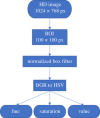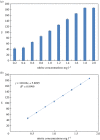Portable device for the detection of colorimetric assays
- PMID: 29291093
- PMCID: PMC5717667
- DOI: 10.1098/rsos.171025
Portable device for the detection of colorimetric assays
Abstract
In this work, a low-cost, portable device is developed to detect colorimetric assays for in-field and point-of-care (POC) analysis. The device can rapidly detect both pH values and nitrite concentrations of five different samples, simultaneously. After mixing samples with specific reagents, a high-resolution digital camera collects a picture of the sample, and a single-board computer processes the image in real time to identify the hue-saturation-value coordinates of the image. An internal light source reduces the effect of any ambient light so the device can accurately determine the corresponding pH values or nitrite concentrations. The device was purposefully designed to be low-cost, yet versatile, and the accuracy of the results have been compared to those from a conventional method. The results obtained for pH values have a mean standard deviation of 0.03 and a correlation coefficient R2 of 0.998. The detection of nitrites is between concentrations of 0.4-1.6 mg l-1, with a low detection limit of 0.2 mg l-1, and has a mean standard deviation of 0.073 and an R2 value of 0.999. The results represent great potential of the proposed portable device as an excellent analytical tool for POC colorimetric analysis and offer broad accessibility in resource-limited settings.
Keywords: colorimetric detection; nitrite detection; pH detection; point of care; portable device; sensors.
Conflict of interest statement
We have no competing interests.
Figures











References
-
- Luka G, et al. 2015. Microfluidics integrated biosensors: a leading technology towards lab-on-a-chip and sensing applications. Sensors 15, 30 011–30 031. (doi:10.3390/s151229783) - DOI - PMC - PubMed
-
- Samiei E, Luka GS, Najjaran H, Hoorfar M. 2016. Integration of biosensors into digital microfluidics: impact of hydrophilic surface of biosensors on droplet manipulation. Biosens. Bioelectron. 81, 480–486. (doi:10.1016/j.bios.2016.03.035) - DOI - PubMed
-
- Cruz P, Mehretu AM, Buttner MP, Trice T, Howard KM. 2015. Development of a polymerase chain reaction assay for the rapid detection of the oral pathogenic bacterium, Selenomonas noxia. BMC Oral Health 15, 95 (doi:10.1186/s12903-015-0071-1) - DOI - PMC - PubMed
-
- Zhang H, Morrison S, Tang Y-W. 2015. Multiplex polymerase chain reaction tests for detection of pathogens associated with gastroenteritis. Clin. Lab. Med. 35, 461–486. (doi:10.1016/j.cll.2015.02.006) - DOI - PMC - PubMed
-
- Medaglia MLG, Sá NMB, Correa IA, Costa LJ, Damaso CR. 2015. One-step duplex polymerase chain reaction for the detection of swinepox and vaccinia viruses in skin lesions of swine with poxvirus-related disease. J. Virol. Methods 219, 10–13. (doi:10.1016/j.jviromet.2015.03.010) - DOI - PubMed
Associated data
LinkOut - more resources
Full Text Sources
Other Literature Sources
